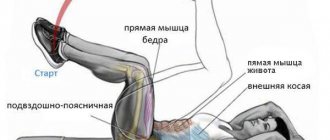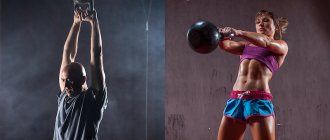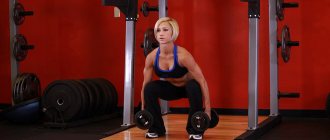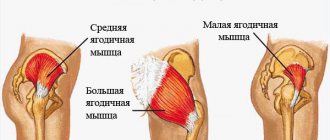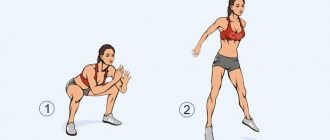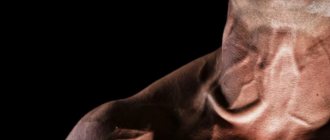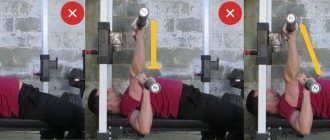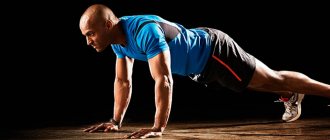Share:
The abdominal cycling exercise is one of the most common exercises among all lovers of sports and a healthy lifestyle. It is aimed at developing the rectus and oblique abdominal muscles. The bicycle exercise is notable for the fact that it involves all the abdominal muscles due to dynamic work from different angles.
This makes cycling the most comprehensive abdominal exercise in principle. In no other exercise can we immediately work out all the muscle groups that interest us. If you are limited in time, but want to properly work out your abdominal muscles, this exercise is ideal.
The bicycle was loved by athletes from all over the world due to its technical simplicity and variations in complexity of execution. It is important that it does not require any exercise equipment or additional equipment - the exercise can be performed anywhere and anytime.
In this article we will look at how to do the bicycle exercise correctly, as well as the following aspects of its implementation:
- what are the benefits of cycling exercise?
- correct execution technique;
- mistakes of beginner athletes;
- variations of the bicycle exercise.
Benefits of exercise bike
The abdominal bicycle exercise can be considered one of the basic and most effective movements, along with crunches and hanging leg raises. Its effectiveness is due to the fact that all the fibers of the abdominal muscles are included in the work. Working in a limited amplitude and non-stop does not allow the muscles to relax even for a second. This leads to hypoxia of muscle fibers and anaerobic glycolysis (muscles quickly reach “failure” due to the retention of lactic acid in the cells).
The exercise loads all parts of the abdominal muscles. It also indirectly engages the latissimus dorsi, iliopsoas, intercostal and serratus muscles, and glutes. Bicycle exercise can also make your abs more prominent and reduce your waist size. And in combination with a low-carbohydrate diet, regular strength and cardio training and vacuum exercises, the desired result will be achieved much faster.
In addition to the obvious benefits in working out the abdominal muscles, cycling exercise can help you lose weight by accelerating your metabolism and accelerating the oxidation of fat cells. It is impossible to determine exactly how many calories cycling burns, but any experienced athlete will confirm that it causes enormous energy expenditure, and due to the strong burning sensation, it can even be difficult to stand after the last set. Of course, subject to the correct technique, which you can find below.
What muscles work
The effectiveness of figure correction exercises is determined by how many parts of the body are involved: the more there are, the more comprehensive and effective the training will be. If we talk about which muscles work during the bicycle exercise, we can mention different groups:
- Back. The latissimus and orbicularis major muscles are involved.
- Stomach. The work of the oblique abdominal muscles is activated.
- Press. Loading from above and below leads to an equally beautiful result.
- Hips. The gluteal and thigh muscles work well during execution.
- Legs. A less active group, but the load is enough to lose weight and increase blood circulation.
Exercise technique
There are several varieties of performing this exercise: with legs raised vertically, with a fitball held between the legs, etc. Now we will look at the most common and effective method, in which the athlete contracts all the abdominal muscles by simultaneously moving the legs, arms and turning the body, and the lower back is pressed to the floor.
Let's take a step-by-step look at the theoretical side of the question of how to do the bicycle exercise for the press, especially since even a beginner can cope with this task:
- Starting position: the athlete lies down on the floor (or gymnastic mat). Bend your knees slightly (about 45 degrees), cross your arms at the back of your head. We press the lower back tightly to the floor and do not tear it off throughout the entire approach, so as not to create unnecessary axial load on the spine and not be distracted from concentrating on the working muscles.
- We move our legs, simulating pedaling when riding a bicycle. The movement should not be strictly vertical, but move slightly in an arc, so the amplitude of the movement will be greater, which means that a larger number of muscle fibers (including oxidative and slow ones) will be involved in the work. The knees should move towards the chest, at the same time we turn the body a little, slightly rounding the back in the thoracic region, and try to reach the knee with the elbow. We work diagonally - we try to reach the left knee with our right elbow, and the right knee with our left elbow.
- Once you have moved your elbows toward your knee, fully extend that leg and bend the other. The same goes for your arms - move your neck slightly to the side to change your elbow. Repeat this movement until you feel a strong burning sensation in your abdominal muscles - this is the main indicator that you are doing everything correctly. The main thing is to do everything smoothly and under control; no sudden movements are allowed here.
Contraindications
When you talk about the benefits of the “Bicycle” exercise, you can’t help but talk about who should not do it. Despite the fact that it does not have particularly serious contraindications, some people should still refuse to perform it. These include:
- Pregnant women and women who have just given birth.
- Men and women with lumbar spine injuries.
- People suffering from problems with the cardiovascular system and inflammatory processes in the body.
Typical mistakes of beginner athletes
Bicycle is a simple exercise from a technical point of view, however, it also has its own little subtleties and secrets, by observing which you can get the maximum benefit from this exercise. Not all of them are obvious at first glance, so many beginners perform this exercise with technical errors. To fix this, you should seek help from a competent personal trainer. Or just read our article to the end, saving your time and money.
Below we will look at how NOT to perform the bicycle abdominal exercise:
- Perform the cycling exercise on a hard, stationary surface. If you do it on a soft surface, you will have less control over the movement and will spend energy on stabilizing the position of the body.
- Do not create an axial load on the cervical spine. When doing a bicycle, we simply place our palms on the back of our heads, but in no case do we press into it with all our strength. Yes, it may seem to you that this makes the exercise somewhat easier, but let’s not deceive ourselves. When training your abs, you should work your abs, not anything else.
- Maintain a uniform pace throughout the entire approach, the movement should be leisurely and smooth. If you do the exercise too quickly, you are unlikely to be able to fully concentrate on stretching and contracting your abdominal muscles.
- Observe the angles that are natural for your anatomy; there should be no discomfort. For example, if you feel an unpleasant stretching sensation in the sacrum area, it means you are raising your legs too much and you should reduce the range of motion.
- Don't chase the number of repetitions. This makes little sense, since in such exercises we first of all need a good muscle contraction due to an established neuromuscular connection. And the number of repetitions and approaches is a secondary matter. Another option is to try cycling for a while, for example, start with 30 seconds and gradually increase the load. So you will subconsciously give yourself a command that the “failure” of your abdominal muscles should occur precisely at the moment the time expires.
- Do not rush to use additional weights in this exercise. Even if you have been training for several years, and your abdominal muscles are strong and well developed, start doing the bicycle with the classic version - this way you will better understand the biomechanics of movement and learn how to correctly contract the abdominal muscles at different angles.
- Variety in the training process is the key to constant progress and athletic longevity. Don't be afraid to experiment and add something new to your training program. For example, the bicycle exercise can be performed either as part of a separate workout for the abs, at the end of a workout for the back or legs, or as part of a CrossFit complex.
Number of approaches and repetitions
The number of approaches and repetitions depends on the level of physical development of the person. With a small number of repetitions, a beginner will pump up the abs well without causing harm to the body.
Training table:
| Athlete level | Number of repetitions | Number of approaches | Rest between sets |
| Beginner (rotation of legs in the air) | 16 | 3 | 90 seconds |
| Advanced (with turns in one direction or the other) | 6 (per side) | 2 | 1 minute |
| Experienced (with turns in one direction or the other) | 10 (per side) | 5 | 1 minute |
Other exercise variations
Above we looked at the most popular method of pumping up the abs using the bicycle exercise. But there are other options that can be roughly divided into simpler and more complex. Choose the one that suits you based on your level of tone and fitness, and find some time to do it as part of your training program.
Let's briefly go through each of them.
Simple options
Bicycle without using elbows and body
A very simple option that is perfect for beginner athletes. The point is that the movement is carried out only due to the movement of the legs - we imitate the pedaling of a bicycle, while the entire body is motionless and pressed tightly to the floor. Your arms can be placed behind your head or extended along your body, it doesn’t matter.
© Syda Productions - stock.adobe.com
Working without connecting the body and elbows, the load shifts to the lower segment of the abs, but almost completely leaves the upper part and oblique abdominal muscles, but the quadriceps, gluteal muscles and hamstrings are additionally loaded.
Bicycle with legs upright
This variety has earned mass love among athletes and sportswomen who are fond of yoga and Pilates. It differs from the previous version in that we raise our legs up almost at a right angle and help ourselves maintain this position throughout the entire approach, resting our hands on the lower part of the lower back (as in the classic birch exercise). The knees are fully straightened and the upper back is pressed to the floor.
The bicycle exercise with legs raised vertically is much simpler due to the fact that we do not work with the elbows and body. Thus, we place additional emphasis on the upper part of the abs, and also perform the exercise in a reduced amplitude - the movement is much shorter than with the classic version. In addition to the physiological benefits, yogis see the benefit of this exercise in the fact that due to increased blood circulation in the lower abdomen, created by simulating pedaling, we additionally stimulate the organs of our reproductive system, thereby increasing our libido and sexual liberation.
Bicycle lying on an inclined bench upside down
If you work out in a gym, it is probably equipped with a special machine for working out the abs, which is an inclined bench with bolsters and a small surface for attaching your arms in the upper part. This machine is perfect for performing bicycle exercises. To do this, you need to sit on it upside down, raise your bent legs and simulate pedaling without connecting your body and elbows, holding your hands on the “pin” at the top of the simulator. The fundamental feature of this type of exercise is that due to the small angle set by the simulator, we create a small additional static load on the lower abdomen.
